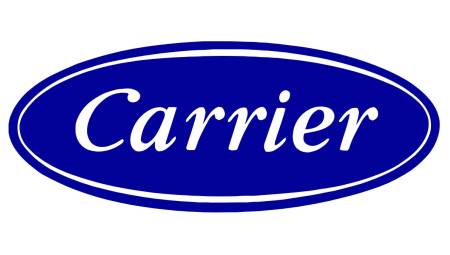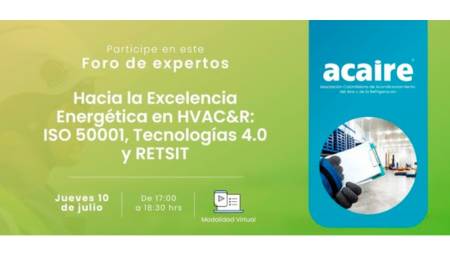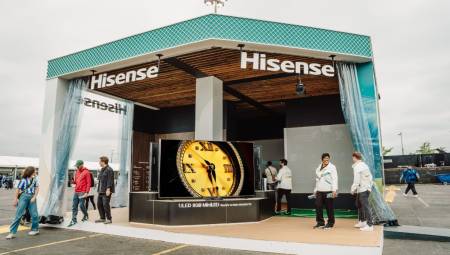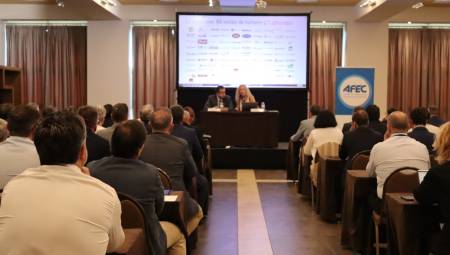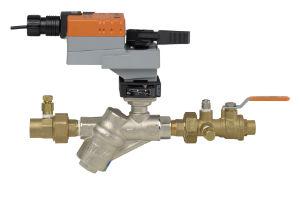 We continue with the second part of this interesting article that refers to the correct monitoring of the behavior of delta T in air conditioning systems that use ice water.
We continue with the second part of this interesting article that refers to the correct monitoring of the behavior of delta T in air conditioning systems that use ice water.
by Julio Londoño*
The implementation of pressure independent valves is a step forward in technology compared to the use of the assembly – position control valve + automatic balancing valve – and is the most suitable solution for variable flow systems.
The biggest benefit of pressure-independent valves is that they simultaneously offer control and roll. So for a given position of the valve the flow will always be the same regardless of the pressure variations in the system. For this reason they are also called flow control valves. In addition to eliminating the overflow caused by pressure variations, they also eliminate balancing valves and the very wasteful and ineffective process of balancing a system.
From the control point of view, these valves facilitate the control of the pump and the configuration of the differential pressure set point of the system. This set point is configured during pump start-up. The following describes the procedure to find it:
With all valves open slowly the speed of the pump is increased until the critical valve reaches the required flow, at that time the differential pressure is measured and that is the adjustment point of the system.
However, the problem comes to partial loads when the valves by position control near the pump oscillate, these cause the differential pressure of the system to also oscillate, forcing the pump to pursue a differential pressure that does not correspond to the actual load. This makes it difficult to find the optimal differential pressure set point. Because pressure independent valves eliminate these oscillations the differential pressure set point obtained is very accurate. This also allows the differential pressure sensor to be installed anywhere in the system and not necessarily through critical equipment.
When starting the pump and to set the differential pressure set point of the system; it must simply be ensured that the last valve has the minimum differential pressure required by the manufacturer.
By using pressure independent valves, all the overflow factors that generate low Delta T syndrome in the coil are eliminated. It is safe to say that for systems with precise sizing of the coils and in optimal cleaning conditions the air conditioning systems with independent pressure valves will work with efficiency levels and Delta T very close to those of design.
But as we mentioned earlier there is another factor that generates under Delta T and that is when there are problems with heat exchange directly on the surfaces of the coil. The first reason is obviously dirt and deterioration of the coils, there is no better solution for this than good maintenance. However, there is another factor that affects the exchange that is inherent in the teams; this is the oversizing of the coils in the handles. Cooling coils are oversized by nature, this is not really a design problem but rather a limitation in the manufacture and availability of equipment.
Coils are manufactured for given capabilities, and when the design requires a value that is between two capacities the coil above is selected, it is very rare for a design to exactly match the capabilities available in the catalog. This oversizing is not as critical when systems are dedicated and working at high loads, but it can be a big problem when working at low part loads; just one more row in the coil means that more water is required and the minimum Delta T is not reached.
This phenomenon occurs frequently in computer centers, where there is a tendency to have oversized equipment working at partial loads and is even more critical when working simultaneously with the backup equipment using less than half of the available capacity of each handler.
Another cause that affects heat exchange is when the coil is supplied with water at a temperature higher than the design temperature, this is a problem in systems with poor insulation or when control sequences are made that raise the set point of the ice water of the cooling plant. The same phenomenon occurs when the air passing through the coil has very wide temperature variations, this is typical of 100% outdoor air handlers or when an economizing damper is enabled.
Smart valves, the solution
The complete solution to the problem of low Delta T syndrome is the use of smart valves. These are independent pressure valves that also have two water temperature sensors and a flow meter connected to the actuator. The actuator has an internal processor that allows it to run advanced calculations and control sequences in addition to storing information. The temperature sensors are installed at the inlet and outlet of the coil, this not only allows to calculate the Delta T, but also with the temperature and flow information the actuator calculates the available power and the energy consumed by the equipment. This energy meter is very useful for operators, because with this information they can schedule maintenance routines in addition to being able to make direct billing of the consumption of their tenants. But from a control standpoint, the benefits these valves offer go much further.
Overflow problems caused by pressure are solved using the pressure-independent component. Heat exchange problems are solved using flow information and Delta T. These smart valves have a control algorithm that monitors coil temperatures and directly optimizes water use, these control the flow and prevent the Delta T of the coil from passing below a configured minimum point (normally this minimum adjustment point is the Delta T design). Preventing the water temperature from falling below a minimum point results in maximum heat exchange and also ensures that the cooling plant does not receive return water below its design Delta T.
In the following graph we can see the amount of water used, the cooling capacity and the behavior of the Delta T for three types of valves. Smart valves use less than half the water of conventional valves; to produce exactly the same amount of cooling.
Smart valves have additional functions that make them a noticeable advance in control technology, with the calculation of power they can control the response of the coil directly using this variable. In this way a linear correlation can be made between the control signal and the effective cooling capacity of the coil. If the controller of the handler or thermostat sends a signal of 6 volts, this does not mean that the temperature control algorithm requires half the flow, what it really means is that it requires half the cooling capacity of the equipment. In this case, such valves modulate the flow to deliver exactly half of the cooling capacity available in the coil. This makes the valve in addition to being pressure independent also independent of the coil characteristic, the valve characteristic and the water temperature.
Why the water temperature?
If the water rises a couple of degrees above its design value, power is lost, then this change is calculated by the valve and immediately adjusts the flow to bring the coil back to its required cooling or power value without the handler's control noticing this change. This function is very useful when very precise temperature or humidity control is required such as in computer rooms, process control, operating rooms, pharmaceutical laboratories, etc.
Being able to control the coil directly with its power opens the doors for advanced control sequences such as demand limit, capacity distribution or flow pump control.
When controlling the demand limit, the objective is to limit the energy consumption of the building to a given level during peak consumption hours, usually to avoid penalties by the energy company. In ice water systems, control sequences that limit demand are not easy to implement without affecting comfort or paradoxically increasing consumption. A very popular strategy is to raise the ice water set point of the chillers during peak hours to save energy, but this strategy heavily penalizes the consumption of the distribution pump and can affect comfort. By being able to control the coil directly with its power, its maximum consumption level can be limited during peak hours and as a consequence the total consumption of the ice water system is limited.
To make capacity distribution, the objective is to limit the cooling capacity of less critical areas, freeing it up for others with greater demand; either in peak consumption hours or when you have a system designed with high diversity. From the Central Control System you can configure a consumption limit in the intelligent valves of the less critical areas. This control strategy can be the solution when you have systems with an installed capacity lower than the demand of the building, or when you have buildings with high diversity because it gives flexibility to the designer to size the air conditioning system according to the individual loads by zones and not based on the total load, as it is typically done.
Control of the pump speed by required flow: as we saw before, the distribution pump is controlled based on the signal of a differential pressure transducer; this method is known as pressure control. Because smart valves communicate flow; the pump can be controlled directly with this information. Using the characteristic curve of the pump, its speed is modulated to deliver the required volume of water and the pressure transducer becomes a support element.
Conclusions
Low Delta T syndrome is a silent enemy, which is why it is important for building operators to monitor the behavior trends of the Delta T of their cooling plant, as this practice will help them avoid cost overruns in the operation.
On the other hand, it is very important that the building is started complying with the design consumption parameters, so that the extra costs are not taken to the normal operating budget. By monitoring the Delta T, not only in the plant but also in the air handling units, the operator will be able to more effectively identify where this waste is generated; this will allow you to better understand the available technologies that can help correct the problem and better concentrate resources on energy-saving projects that deliver the greatest benefits, adding stability to the system and without detracting from the comfort of the building's occupants.
* During the development of this article, Julio Londoño worked for Belimo Air Controls, now he does it for Carier. To learn more about the technologies mentioned, you can write to [email protected]





